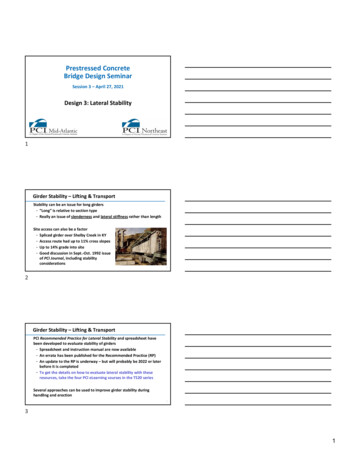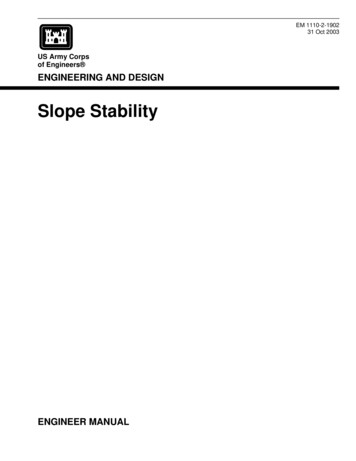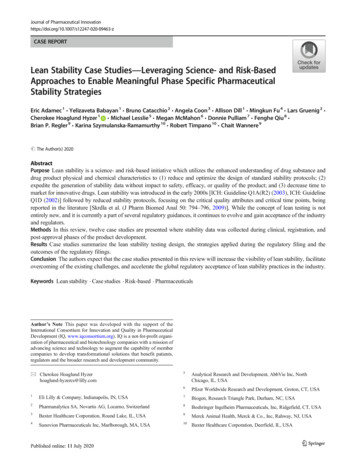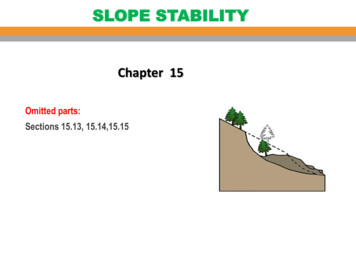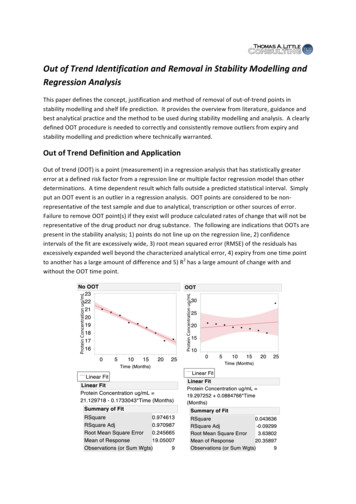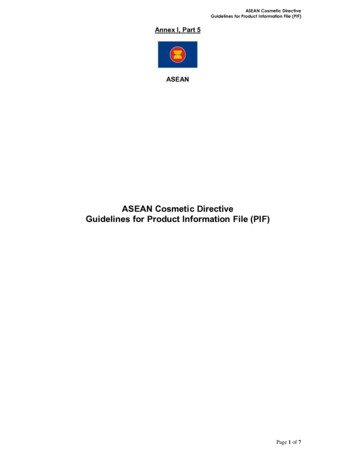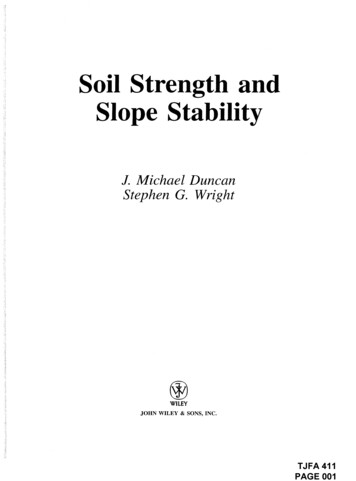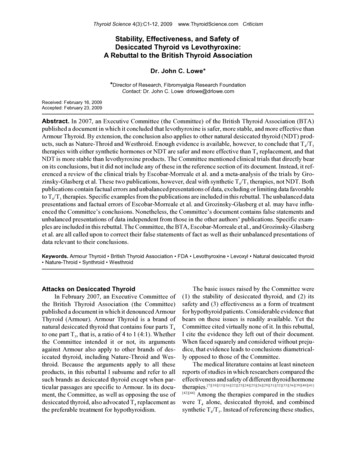
Transcription
Thyroid Science 4(3):C1-12, 2009www.ThyroidScience.com CriticismStability, Effectiveness, and Safety ofDesiccated Thyroid vs Levothyroxine:A Rebuttal to the British Thyroid AssociationDr. John C. Lowe**Director of Research, Fibromyalgia Research FoundationContact: Dr. John C. Lowe drlowe@drlowe.comReceived: February 16, 2009Accepted: February 23, 2009Abstract. In 2007, an Executive Committee (the Committee) of the British Thyroid Association (BTA)published a document in which it concluded that levothyroxine is safer, more stable, and more effective thanArmour Thyroid. By extension, the conclusion also applies to other natural desiccated thyroid (NDT) products, such as Nature-Throid and Westhroid. Enough evidence is available, however, to conclude that T4 /T3therapies with either synthetic hormones or NDT are safer and more effective than T4 replacement, and thatNDT is more stable than levothyroxine products. The Committee mentioned clinical trials that directly bearon its conclusions, but it did not include any of these in the reference section of its document. Instead, it referenced a review of the clinical trials by Escobar-Morreale et al. and a meta-analysis of the trials by Grozinsky-Glasberg et al. These two publications, however, deal with synthetic T4 /T3 therapies, not NDT. Bothpublications contain factual errors and unbalanced presentations of data, excluding or limiting data favorableto T4 /T3 therapies. Specific examples from the publications are included in this rebuttal. The unbalanced datapresentations and factual errors of Escobar-Morreale et al. and Grozinsky-Glasberg et al. may have influenced the Committee’s conclusions. Nonetheless, the Committee’s document contains false statements andunbalanced presentations of data independent from those in the other authors’ publications. Specific examples are included in this rebuttal. The Committee, the BTA, Escobar-Morreale et al., and Grozinsky-Glasberget al. are all called upon to correct their false statements of fact as well as their unbalanced presentations ofdata relevant to their conclusions.Keywords. Armour Thyroid British Thyroid Association FDA Levothyroxine Levoxyl Natural desiccated thyroid Nature-Throid Synthroid WesthroidAttacks on Desiccated ThyroidIn February 2007, an Executive Committee ofthe British Thyroid Association (the Committee)published a document in which it denounced ArmourThyroid (Armour). Armour Thyroid is a brand ofnatural desiccated thyroid that contains four parts T4to one part T3 , that is, a ratio of 4 to 1 (4:1). Whetherthe Committee intended it or not, its argumentsagainst Armour also apply to other brands of desiccated thyroid, including Nature-Throid and Westhroid. Because the arguments apply to all theseproducts, in this rebuttal I subsume and refer to allsuch brands as desiccated thyroid except when particular passages are specific to Armour. In its document, the Committee, as well as opposing the use ofdesiccated thyroid, also advocated T4 replacement asthe preferable treatment for hypothyroidism.The basic issues raised by the Committee were(1) the stability of desiccated thyroid, and (2) itssafety and (3) effectiveness as a form of treatmentfor hypothyroid patients. Considerable evidence thatbears on these issues is readily available. Yet theCommittee cited virtually none of it. In this rebuttal,I cite the evidence they left out of their document.When faced squarely and considered without prejudice, that evidence leads to conclusions diametrically opposed to those of the Committee.The medical literature contains at least nineteenreports of studies in which researchers compared theeffectiveness and safety of different thyroid 6][29][31][32][33][36][39][40][41][42][44]Among the therapies compared in the studieswere T4 alone, desiccated thyroid, and combinedsynthetic T4 /T3 . Instead of referencing these studies,
2Lowe, J.C.: Stability, effectiveness, and safety of desiccated thyroid . . . . Thyroid Science 4(3):C1-12, 2009however, the Committee cited only two papers inwhich authors reviewed the most recent studies thatcompared T4 monotherapy to synthetic T4 /T3 . One ofthose papers is a review of the studies by EscobarMorreale et al.,[17] and the other is a report of a metaanalysis by Grozinsky-Glasberg et al.[18]In this paper, I critically dissect relevant parts ofthe two papers cited by the Committee. I also showthat both papers contain errors that misinform readerswho take the authors’ statements at face value.Members of the Executive Committee appear to beamong the misinformed. I include citations belowthat indicate that the Committee accepted withoutquestion and reiterated false statements of the authorsof the two papers. Possibly as a result of this, butapparently for other reasons, the Committee’s document contains falsehoods that I cite below. As will beobvious to readers, only if the falsehoods were truecould the Committee validly deduce its conclusionsabout T4 replacement and desiccated thyroid. But theevidence I present shows that the falsehoods areindeed false.Issues Raised by the Committeeof the British Thyroid Association (BTA)The Committee contends that T4 is more stable,safer, and more effective than desiccated thyroid.This proposition, however, is a mere presumption,one that is refuted by evidence that I present below.The Committee bulwarks its proposition only with anunbalanced presentation of some evidence, and falseclaims about other relevant evidence.As I document below, contrary to the conclusionsof the Committee, the evidence actually shows thatcompared to desiccated thyroid, T4 is less stable.Moreover, replacement therapies (dosages of thyroidhormone that keep the TSH level within its current—but often revised—reference range), includingT4 replacement and T4 /T3 replacement, are ineffectivefor many patients and potentially harmful to them.Because of its documented ineffectiveness formany patients and its potential harm, T4 replacementshould be abandoned as the thyroid hormone therapyof choice. Clinicians should preferably typicallyprescribe desiccated thyroid or synthetic T4 /T3 indosages larger than replacement dosages. I base thisrecommendation on several findings: (1) hypothyroidpatients have long used desiccated thyroid safely andeffectively, (2) some studies show desiccated thyroidto be at least as effective as T4 replacement, and (3)two studies showed that patients who used T4 /T3therapy in a 5:1 ratio—close to the 4:1 ratio indesiccated thyroid—had no adverse effects (whilepatients using T4 alone did) and were more satisfiedwith the combination therapy than with T4 alone (seeFigures 1 and 2).Invalid ConclusionWhen Bunevicius et al. reported improvement incognitive function after patients substituted 12.5mcg of T3 for 50 mcg of their T4 dosage,[7] otherresearchers quickly conducted four studies in whichthey compared the effectiveness of T4 replacement toT4 /T3 replacement. The ratio of T4 to T3 that patientsin the studies used was far higher than the 4:1 ratioin Armour, Nature-Throid, and Westhroid desiccatedthyroid. One aim in the studies was to keep patients’TSH levels within the reference range, which makesthe tested T4 /T3 treatments a form of “replacement.”No difference was found between the two typesof replacement therapies. Based on this finding, theendocrinologists who conducted the studies,[23][24][25]others,[26] and endocrinologists who wrote editorials
Lowe, J.C.: Stability, effectiveness, and safety of desiccated thyroid . . . . Thyroid Science 4(3):C1-12, 2009about the studies,[30][43] made a logical error. By usingincorrect universal propositions rather than correctsingular ones, they sweepingly denounced as no moreeffective than T4 replacement all T4 /T3 therapies—not just the T4 /T3 replacement tested in thestudies.They did not bother to note that the T4 /T3 therapythey studied was not the T4/T3 therapy long used byclinicians who have reported treatment resultssuperior to those of T4 replacement. That superiortreatment was the use of desiccated thyroid andsynthetic T4 /T3 products with a T4 /T3 ratio of 4:1 orlower. I first reported this logical error of the endocrinology researchers and editorialists in 2003 andagain in 2006.[8] But to this date none of them haveresponded. I hope that the British Thyroid Association (BTA) will not be similarly silent. (For a detailed description of the endocrinologists’ logicalerror, see my critique of the first four T4 vs T4/T3studies that followed the 1999 Bunevicius study.[8,pp.24])The Committee made the same error as the researchers who conducted the T4 replacement vs T4 /T3 replacement studies and the endocrinologists whowrote editorials about them. I would like to remindthe Committee of the words of one of their countrymen who was one of the greatest intellects in history,Lord Bertrand Russell: “I do like clarity and exactthinking, and I believe that very important to mankind. Because, when you allow yourself to think inexactly, your prejudices, your bias, your self interestcome in in ways you don't notice, and you do badthings without knowing that you're doing them. Selfdeception is very easy. So I do think exact thinkingimmensely important.”[5]Instability of T4 ProductsEric P. Duffy, PhD is Director, Division of PostMarketing Evaluation Office of New Drug QualityAssessment, OPS, FDA. In 2006, he presented a slidepresentation titled “Stability Of LevothyroxineSodium Products.”[2] On slide 8, Dr. Duffy wrote:“Levothyroxine Tablet Stability: Levothyroxine sodium (T4 ) is labile to [prone to reduced potency by]the following: Heat, moisture, oxidative conditions,chemical reactions. These conditions typically occurduring levothyroxine formulation, tableting, packaging, and storage.” He then wrote, “Many levothyroxine drug products have exhibited: history ofsub-optimal stability profile, significant loss of po-3tency over shelf life, [and] inconsistent stabilityprofiles within an individual manufacturer’s drugproduct line.” (Italics mine.)Another FDA scientist, Steven B. Johnson,Pharm.D., is with the Division of PharmaceuticalEvaluation II of the FDA. In a 2003 slide presentation, he said, “Levothyroxine degrades quickly withexposure to light, moisture, oxygen, and carbohydrate excipients.”[3,slide 5] He noted that over the years,companies worked to improve the stability of theirlevothyroxine products, and significant changes occurred.[3,slide 6] Obviously, stability was a problem;why else would companies work to improve stability? In fact, the stability problem has been so substantial that until the FDA stopped the practice, manycompanies engaged in “stability overage”; that is,the companies would add more than 100% of the T4designated on the product label. They did so becausethey assumed that potency would be lost, and theycompensated for the loss by packing extra T4 into thetablets.[2,slide 9][3,slide 5]The instability of levothyroxine tablets is noteworthy, especially in view of the Committee’s claimthat levothyroxine products are more stable than desiccated thyroid products. Dr. Johnson cited the FDArecall record of levothyroxine: “Between 1990 and1997: 10 recalls, 150 lots, and 100 million tablets.”[3,slide 5] (Italics mine.) The reasons for the FDArecalls are also noteworthy: “Content uniformity,sub-potency, and stability failures.”[3,slide 5]Whether intentional or not, the BTA’s ExecutiveCommittee painted a grossly imbalanced picture ofthe comparative stability of desiccated thyroid andlevothyroxine. The Committee clearly cast an unfavorable light on desiccated thyroid by presenting themeager evidence against it, while failing to disclosethe copious evidence against T4 . The fact is that thestability of levothyroxine has been far more in question at the FDA than has that of desiccated thyroid.Stability of Natural Desiccated ThyroidAccording to the Committee: “The concentrationof thyroid hormones in Armour Thyroid USP isregulated by the manufacturer to United States Foodand Drug Administration (FDA) standards. Despitethis, there have been significant problems with thestability of Armour Thyroid in recent years, prompting a massive recall of tablets.” (Italics mine.) TheCommittee also wrote, “An FDA enforcement removed more than half a million bottles of Armour
4Lowe, J.C.: Stability, effectiveness, and safety of desiccated thyroid . . . . Thyroid Science 4(3):C1-12, 2009Thyroid from US pharmacies in 2005 due to unstableconcentrations of thyroid hormone in thepreparation.”[1] Indeed, batches of the product wererecalled in 2005.[9] But the Committee mentions“problems with the stability . . . in recent years.”(Italics mine.) This suggests that the FDA has repeatedly recalled Armour batches in two or moreyears. But the Committee cites only the 2005 recall;I cannot find documentation for others.The Committee’s purpose in citing the Armourrecall appears to have been to implicitly argue thatlevothyroxine products (levothyroxine sodium, thyroxine, and T4 ) are more stable than desiccatedthyroid products. If so, the Committee engaged incard-stacking of evidence, as it failed to disclose ahighly relevant fact: the T4 products Synthroid andLevoxyl have been recalled far more often thanArmour, Nature-Throid, or Westhroid—all desiccated thyroid hormone products. In fact, Nature-Throidand Westhroid have never been recalled for instability.Anyone with Internet access can view the publicrecord at www.fda.gov/search.html. Searches showthat the many recalls of T4 products dwarf the fewrecalls of desiccated thyroid.Clinicians and patients interested in the relativemerits and demerits of T4 and desiccated thyroidshould be aware that desiccated thyroid products arenot carelessly produced. The Committee failed tonote that manufacturers of desiccated thyroid takeproper steps to ensure its potency before the productsare shipped to pharmacies. For example, themanufacturer of Nature-Throid and Westhroid Thyroid USP tablets takes appropriate steps to ensureconsistent potency from tablet-to-tablet and lot-to-lot.The manufacturer not only performs analytical testson the raw material (Thyroid USP powder), but alsoon the tablets (finished products) to measure actualT4 and T3 activity.[11] As a result of this attention toquality, only two recalls—voluntary ones—haveoccurred in the past eight years. These recalls included fewer than one hundred bottles. The recallswere for a labeling problem, not for instability orpotency variability as with levothyroxine products.Ineffectiveness of T4Replacement for Many PatientsThe endocrinology specialty has long claimedthat T4 replacement is effective for most hypothyroidpatients, and that patients need no other treatmentsuch as T4 /T3 therapy. However, as I wrote in a 2006review (and in 2003) of four T4 vs T4 /T3 studiespublished in 2003, T4 replacement is ineffective formany hypothyroid patients.[8,p.14] At that time, at leastsix studies had shown this to be true.[7][15][16][23][24][25][26][27][28]As I said above, in the 1999 Buneviciusstudy[7] patients who had been on T4 replacementsubstituted 12.5 mcg of T3 for 50 mcg of their usualT4 dosages. The neuropsychological function of patients who added T3 to their treatment improved. It isobvious but worth emphasizing that from the patients’ improved neuropsychological function, it follows that their previous T4 monotherapy had failedto provide them the higher level of function thatT4 /T3 provided.In a large, community-based questionnaire studyin 2002,[27] researchers evaluated the health status ofhypothyroid patients using T4 replacement therapy.Compared to matched control patients, hypothyroidpatients on “adequate” dosages of T4 had a higherreported incidence of four diseases: depression, hypertension, diabetes, and heart disease. Hypothyroidpatients on inadequate T4 replacement (their TSHlevels were elevated) also had a higher incidence ofstrokes. In addition, hypothyroid patients chronicallyused more prescription drugs, especially for diabetes, cardiovascular disease, and gastrointestinal conditions. Patients on T4 replacement had scores 21%higher (worse) than controls on the General HealthQuestionnaire. The researchers wrote, “This community-based study is the first evidence to indicatethat patients on thyroxine replacement even with anormal TSH display significant impairment in psychological well-being compared to controls of similar age and sex.”[27,p.577]In the study by Cassio et al.,[26] researcherstreated infants who had congenital hypothyroidismwith either T4 or T4/T3 replacement. The infants hadscores on psychological tests that were lower thanthose of infants who were not hypothyroid. The tworeplacement therapies did not improve the scores ofthe hypothyroid infants, so their psychological impairment presumably persisted.To take part in the Sawka et al. study,[24] patientson T4 replacement had to have test evidence of depression: that is, they had to have, “. . . evidence ofdepressive symptoms as defined by a score of morethan 5 on the 30-item General Health Questionnaire
Lowe, J.C.: Stability, effectiveness, and safety of desiccated thyroid . . . . Thyroid Science 4(3):C1-12, 2009. . . on 2 occasions, at least 2 wk apart.”[24,p.4551] Theresearchers found that replacement therapies werenot effective for the patients and, again, presumablyleft them depressed.In the Walsh et al. study,[23] typical symptomssuffered by hypothyroid patients who were dissatisfied with their T4 replacement included “tiredness,impaired well-being, or weight gain.”[23,p.4544] Thestudy showed that replacement therapies were ineffective for these patients and left them sufferingfrom their symptoms.In addition to the four studies I just mentioned,two other studies also showed the ineffectiveness ofT4 replacement.[15][16] The study by Escobar-Morrealeet al.[15] is especially informative. The researchers reported that patients on both T4 and T4 /T3 replacement“performed worse than controls in the time score andVisual Scanning Test . . . .”[15,p.420] But patients whoused a 5:1 ratio of T4 and T3 did not perform worsethan the healthy control subjects. Also, patients on T4and T4 /T3 replacement therapies did worse thanhealthy controls on two other tests (isovolumicrelaxation time and brainstem evoked potentials), butpatients who used T4 and T3 in a 5:1 ratio did not doworse than controls.[15,p.420] This positive result for 5:1T4 /T3 therapy is evidence from Escobar-Morreale etal. that the therapy was more effective than the twoforms of replacement therapy.False Reporting by the Committee,Escobar-Morreale et al., and GrozinskyGlasberg et al.In this rebuttal to the Committee of the BTA, Icite incidences of unbalanced presentation of datathat deny readers an accurate understanding of theresearch concerning the relative stability, safety, andeffectiveness of desiccated thyroid as comparted tosynthetic T4 products. In the pursuit of scientifictruth, these instances of unbalanced presentation arelamentable. However, the Committee, Escobar-Morreale et al., and Grozinsky-Glasberg et al. gave falsereports concerning the research data that are an evenmore egregious departure from accurate reporting.The Committee’s extrapolation that T4 /T3therapies provide no benefitsThe Committee of the BTA wrote, “Since thisinitial study, [the 1999 Bunevicius et al. study[7]]there have been a further [sic] seven rigorously con-5ducted (‘randomized, double-blind, placebo-controlled’) studies . . . . None of the subsequent studiesshowed a beneficial effect of combined T4 /T3 therapyon measures of wellbeing, health and mental functioning.” (Italics mine.) The Committee concluded,“. . . combined T4 /T3 cannot be recommended because of a lack of benefit . . . .” The studies of T4/T3therapy the Committee referred to involved synthetichormones, none of which were used in the 4:1 T4 /T3ratio as contained in desiccated thyroid. But in itsdocument, the Committee implies by extrapolationthat desiccated thyroid, too, cannot be recommendedbecause of a lack of benefit.I request that the Committee reconcile its conclusion, at the very least, with the evidence I cite inthis section. This evidence directly contradicts theirconclusion. Older studies show that T4 /T3 in theform of desiccated thyroid was at least as effectiveas synthetic T4 . As Cobb and Jackson wrote in adrug therapy review, desiccated thyroid products areequipotent to T4 alone in treating hypothyroidism.[19,p.53] This was determined by a study of thepotency of desiccated thyroid using an antigoitrogenic assay in rats.[13] Most studies of T4 /T3 therapyhave not been of desiccated thyroid itself, althoughat least 11 studies did directly compare desiccatedthyroid to T4 alone.[4][29][31][32][33][35][37][38][39][40][42] TheCommittee, however, did not cite these studies; instead, it extrapolated to desiccated thyroid fromstudies that compared synthetic T4 to synthetic T4 /T3combinations. Reading the same studies the Committee referred to makes clear that its claim of a lackof benefit of desiccated thyroid is false.First Bunevicius Study. In a study publishedin 1999, Bunevicius et al.[7] included 26 hypothyroidwomen. Eleven had autoimmune thyroiditis and 15had been treated for thyroid cancer. Patients eithercontinued their usual dose of T4 , or they substituted12.5 mcg of T3 for 50 mcg of their usual dosage ofT4 .Bunevicius et al. later wrote that when patientswere undergoing T4 /T3 therapy, they had “clear improvements in both cognition and mood, the latterchanges being greater.” [21,p.167] The researchers alsowrote, “The patients who had been treated for thyroid cancer showed more mental improvement thanthe women with autoimmune thyroiditis . . . .”[21,p.167]However, patients in both groups improved on somemeasures.[21,pp.169-171]
6Lowe, J.C.: Stability, effectiveness, and safety of desiccated thyroid . . . . Thyroid Science 4(3):C1-12, 2009This is important to note because in the reviewpaper that the Committee cited, Escobar-Morreale etal. falsely reported that only thyroid cancer patientsimproved. Specifically, they wrote, “. . . the presumed benefits of T3 substitution were restricted toathyreotic thyroid cancer patients . . . .”[17,p.4949] Consider, however, what Bunevicius and Prange actuallyreported: Referring to visual analog scales, theywrote, “The advantages [improvements] for combined treatment were statistically significant in the . . [autoimmune thyroiditis] group on 4 scales, in the. . . [thyroid cancer] group on 6 scales.”[21,p.170] Table5 in Bunevicius and Prange’s report shows this to betrue.[21,p.172] Escobar-Morreale et al., then, are guiltyof false reporting.Second Bunevicius Study. In the secondBunevicius study,[22] patients were hypothyroid fromthyroidectomy for Graves’ disease. The patients substituted 10 mcg of T3 for 50 mcg of their usual T4monotherapy dose. In their first study, Bunevicius etal. substituted 12.5 mcg of T3 for 50 mcg of T4 .[7]Despite the more modest substitution dose of 10 mcgof T3 in the second study, the results indicated thatpatients improved with T4 /T3 therapy.Compared to baseline scores when patients wereusing T4 replacement, the patients had statisticallysignificant improvement on three measures.[22,p.130]Allowing for a slightly larger significance level (p 0.06), the patients using T4 also improved on oneother measure—a total of four measures. Similarly,when patients used T4 and T3 , they significantly improved on three measures. But allowing for slightlylarger significance levels (p 0.06 to 0.08), these patients also improved on four more measures—a totalof seven measures. This means that with T4 alone,patients improved on four measures, while on T4/T3,they improved on seven. With the slightly expandedsignificance levels, then, patients improved morewith T4 and T3 combined than they did on T4 alone.Bunevicius et al. wrote: “Thus, to a statisticallysignificant degree, the substitution of 10 mcg of T3reduced the concentration of free T4 , as well as thesymptoms of hypothyroidism and subjective tension,while improving pairs recalled on the Digit SymbolTest. In addition, it tended to reduce the symptoms ofhyperthyroidism, to improve mood on the BeckDepression Inventory, as well as feelings of confusion on the Visual Analog Scale, and to improve theraw score on the Digit Symbol Test and forward recall on the Digit Span Test.”[22,pp.131-132]In the 2005 Saravanan study,[14] patients substituted 10 mcg of T3 for 50 mcg of their T4 dosages.The researchers wrote that patients on the differenttherapies had no differences in a number of testscores. However, patients who used T4 /T3 had someimprovements compared to patients who used T4alone. The researchers reported, “ . . . a significantlygreater reduction in psychiatric caseness [patientswho met the criteria for different disorders] was seenin the T3 group compared with T4 alone . . . .Improvement was also seen in the HADS anxietyscore [the Hospital Anxiety and Depressionquestionnaire] at 3 months.”[14,p.807] (Italics mine.)Patients’ Preference for T4 /T3 Therapy.The Committee wrote that in two studies in whichresearchers compared T4 to T4 /T3 therapy, patientspreferred T4 /T3 therapy. This is a factual error by theCommittee. Actually, patients preferred or weremore satisfied with T4 /T3 therapy in five studies.[7][15][16][22][36]In each of the five studies, far more patientspreferred T4 /T3 therapy over T4 replacement. Combining the preference data from the five studies, of236 patients, 110 patients had no preference. Only27 patients preferred T4 replacement while 99 preferred some form of T4 /T3 therapy. (See Figure 3.)In two studies,[15][16] patients used T4/T3 in a ratioof both 10:1 and 5:1. Of the 61 patients involved, 31preferred the 10:1 ratio; 30 preferred the 5:1 ratio.One of the five studies was published in1999,[7] another in 2002,[22] and three others in2005[15][16][36]—all well before the 2007 Committeedocument published by the British Thyroid Association.[1] Despite this, the Committee failed to mention that patients preferred T4 /T3 therapies. Perhapsthis neglect of the Committee was due to its dependence on the reviews by Escobar-Morreale et al.[17]
Lowe, J.C.: Stability, effectiveness, and safety of desiccated thyroid . . . . Thyroid Science 4(3):C1-12, 2009and Grozinsky-Glasberg et al.[18] rather than the original study reports the reviewers purportedly analyzed. In any case, neglecting this important findingconstitutes an unbalanced presentation of data thatfavors T4 replacement over T4 /T3 therapies.The 1999 and 2002 studies that the Committeedid not reference were the first and second Bunevicius et al. studies.[7][22] At the end of the 1999 study,the researchers asked patients about their preferencesfor a particular form of treatment. The researcherswrote, “When asked at the end of the study whetherthey preferred the first or second treatment, 20patients preferred thyroxine plus triiodothyronine, 11had no preference, and 2 preferred thyroxine alone(p 0.001).”[7,p.427] (See Figure 4.)At the end of the 2002 study, the researchersasked patients about their preferences. “Six patients,”they wrote, “preferred combined treatment, reportingincreased energy, better performance, and decreased‘tension in the eyes.’ Two preferred monotherapywith T4 , and two found no difference.”[22,p.132] (SeeFigure 5.)7In the Applehof et al. study, patients who usedT4 /T3 therapy were more satisfied with the treatment.In fact, the researchers found a linear relationshipbetween the use of T3 and the number of patientspreferring treatment: In the T4 monotherapy group,only 29.2% were satisfied with the treatment; in thegroup who used T4 /T3 therapy in a 10:1 ratio, 41.3%were satisfied; and in the group that used T4 /T3 therapy in a 5:1 ratio, 52.2% were satisfied. (See Figure1.)Escobar-Morreale et al.[15] and Rodriquez et[36]al.also reported more satisfaction with T4 /T3therapies (see Figures 2 and 6). Unfortunately, Grozinsky-Glasberg et al., for all practical purposes,gave no attention to patients’ preference for T4 /T3therapies. To their credit, Escobar-Morreale et al.did mention patients’ preference for T4 /T3 in theirabstract, the body of their review, and in their conclusion section.[15]In some studies, researchers did not inquire about patients’ satisfaction with tested therapies. In theWalsh et al.[23] study the researchers did inquire, andthere was no difference in patients’ preferences.The Committee’s parroting of falsestatements by Escobar-Morreale et al.and Grozinsky-Glasberg et al.The Committee wrote, “There is no evidence tofavour the prescription of Armour Thyroid in thetreatment of hypothyroidism over the prescription ofthyroxine sodium.”[1] The Committee appears tohave argued against desiccated thyroid by appropriately including it among T4 /T3 therapies. Its claimof no benefit of these therapies over T4 replacement,however, is false. It is possible that the source of theCommittee’s erroneous conclusions are false statements by Escobar-Morreale et al. and GrozinskyGlasberg et al. in their reviews of the studies testingT4 alone vs T4 /T3 therapies.As Figures 1 through 6 show, patients’ satisfaction is a benefit often provided by T4 /T3 therapies. Intheir meta-analysis of the T4 vs T4 /T3 studies, Grozinsky-Glasberg et al. side-stepped this importantfinding. They merely included the term “satisfaction” in a table,[16,p.2594] and they briefly mentionedpatients dissatisfied with T4 replacement.[16,p.2597]They did not include the words “prefer” or “preferred” in their paper, and they did not include thedata from the five studies in which patients by far
8Lowe, J.C.: Stability, effectiveness, and safety of desiccated thyroid . . . . Thyroid Science 4(3):C1-12, 2009preferred T4 /T3 therapies.Keep in mind that Applehof et al. reported thatweight loss with T4 /T3 therapy correlated with pat
Thyroid Science 4(3):C1-12, 2009 www.ThyroidScience.com Criticism Stability, Effectiveness, and Safety of Desiccated Thyroid vs Levothyroxine: A Rebuttal to the British Thyroid Association Dr. John C. Lowe* *Director of Research, Fibromyalgia Research Foundation Contact: Dr. John C. Lowe drlowe@drlowe.com Received: February 16, 2009
